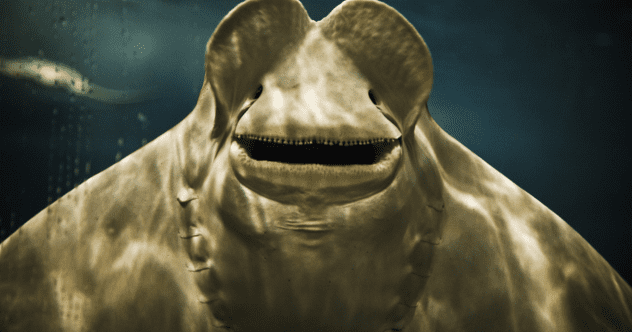Prepare to chuckle as we announce some of the wackiest names Mother Nature has given to her creations. From the hilariously named “Wonderpus” to the oddly titled “Go-away Bird,” these critters prove that when it comes to names, truth can indeed be stranger than fiction. Here are ten species with the weirdest names:
Related: 10 Weird Place Names And The Stories Behind Them
10 Penis Snake
‘Penis Snake’ Exposed by Amazon Dam Construction
The penis snake is truly a star in the constellation of bizarrely named creatures. Before your imagination runs wild, let’s get the facts straight about this critter.
First off, it’s not some mystical serpent with powers. No, it’s an amphibian, specifically a species of caecilian called Atretochoana eiselti. But “penis snake” rolls off the tongue better than its scientific name. And boy, does it look the part. Picture a limbless creature resembling… well, you guessed it, a certain male appendage.
Found lurking in the murky waters of the Amazon basin, the penis snake is quite a mystery. With a body adapted for burrowing, it spends most of its time underground, surfacing only to take a breath or, presumably, to raise a few eyebrows with its unique appearance.
The penis snake also has a secret talent—it’s a lungless amphibian. It breathes through its skin like an aquatic yoga master. Talk about evolutionary innovation. Despite its phallic facade, the penis snake isn’t even a snake. It’s more closely related to frogs and salamanders. Go figure!
9 Lumpsucker
The Lumpfish: Most Adorable Fish Ever With Built-In Suction Cup
Say hello to the lumpsucker, the fish with a name that sounds more like a rejected cartoon character than an aquatic marvel. You’re not far off the mark if you picture a fish covered in lumps.
Lumpsuckers belong to the family Cyclopteridae, which might not roll off the tongue. Still, it’s better than being called the “lumpy fish family.” These chubby buddies are found in cold waters worldwide, from the Arctic to the North Pacific. They might not win any beauty pageants, but their round, bulbous bodies and suction cup-like pelvic fins have a unique charm.
Despite their rather… unconventional appearance, lumpsuckers are pretty skilled hunters. They use those suction cup fins to attach themselves to rocks or other surfaces, patiently waiting for unsuspecting prey to swim by. Talk about using what your mama gave you.
Lumpsuckers aren’t just skilled hunters. They’re also devoted parents. After laying their eggs in rocky crevices, the males guard them until they hatch—it’s like the ultimate dad move in the animal kingdom.
8 Blue-Footed Boobies
The Blue Footed Boobies Mating Dance | Wild Love
Meet the blue-footed boobies, the avian fashionistas of the Galápagos Islands. With their distinctive tootsies stealing the show, these birds are more than just a pair of fancy feet.
These seabirds are experts at aerial acrobatics, diving into the ocean at breakneck speeds to catch their dinner. With pinpoint precision, they plunge from great heights, hitting the water with the finesse of an Olympic diver.
And those blue feet? They’re not just for show. They play a crucial role in courtship displays. During mating season, male boobies strut their stuff, lifting their feet and showing off their blue appendages in a dance that would make even the most seasoned dancer jealous.
Despite their appearance and flashy moves, blue-footed boobies face threats in the wild, including habitat destruction and overfishing. Conservation efforts are underway to protect these birds and ensure that future generations can enjoy their quirky look.
7 Go-Away Bird
Grey Go Away Bird | Birds of the Bush | EcoTraining
The go-away bird (Crinifer concolor) is the avian embodiment of a grumpy neighbor. Found in sub-Saharan Africa, these birds sport an impressive tufted crest that would make any punk rocker envious. Their plumage may not be as colorful as some of their tropical cousins, but they rock the monochrome look with flair.
When disturbed, these birds unleash a distinctive call that sounds like “go-away”—talk about being direct. It’s like they have a built-in “Do Not Disturb” sign but with sound effects. Thankfully, their loud warning calls alert other creatures to potential dangers.
Despite their antisocial tendencies, go-away birds play a role in their ecosystem. They feast on a diet of fruits, insects, and the occasional small reptile, helping to keep the balance of nature in check.
6 Sarcastic Fringehead
Sarcastic Fringehead Fights For Territory | Life | BBC Earth
Found off the coast of California, the sarcastic fringehead packs a punch—literally. They’re small, about a foot long, but don’t let their size fool you. When two farcastic fringeheads disagree, they engage in what can only be described as a “mouth battle.” They open their disproportionately large mouths wide and shove them against each other, almost like a kiss from hell. It’s not a pretty sight, but it sure is entertaining.
Sarcastic fringeheads are ferocious predators. They’ll gobble up anything that fits in their gaping mouths, including fish, crustaceans, and unsuspecting scuba divers’ fingers (okay, maybe not that last one, but they sure look like they could).
Contrary to their fierce reputation, sarcastic fringeheads are surprisingly good parents. Females carefully lay their eggs in empty shells or crevices, and males dutifully guard the nest until the eggs hatch. It’s a challenging task, but one that they undertake with a touch of sarcasm, of course.
5 Wunderpus
Facts: The Wunderpus Octopus (Wunderpus photogenicus)
Ah, the wunderpus. If you’re looking for a creature with a name that sounds like it belongs in a fairy tale rather than the ocean, look no further. Meet the Wunderpus photogenicus, the undisputed champ of quirky underwater names.
Let’s address the obvious: “Wunderpus photogenicus” sounds like the scientific community just couldn’t resist complimenting this cephalopod’s good looks. And can you blame them? With its mesmerizing patterns and graceful movements, this critter practically begs for a photo shoot.
This eight-armed wonder hails from the same family as the equally famous mimic octopus, known for its shape-shifting skills. While the mimic octopus copies marine creatures to evade predators, the wunderpus prefers to keep things simple. It relies on its appearance to blend in with its surroundings, camouflaging itself among the coral and sandy seabeds of the Indo-Pacific.
Unlike some of its relatives, the wunderpus is a homebody, preferring to stick close to its burrow rather than move around the ocean floor. And if you’re lucky enough to spot one in the wild, don’t expect a flashy performance. These creatures are masters of disguise and tend to avoid the spotlight whenever possible.
4 Slippery Dick
Fish ID – Slippery Dick Wrasse
Slippery dick—the fish with a name that sounds like it belongs in a comedy sketch. But don’t let the hilarious name fool you. This fish means business. Halichoeres bivittatus, or the slippery dick, is a colorful character roaming the coral reefs of the Western Atlantic. With its vibrant hues and playful antics, this fish is as charming as it is peculiar.
Why “slippery dick”? Legend has it that this slippery fellow earned its title from its elusive nature, darting and dodging like a master escape artist. But this isn’t some aquatic prankster. The slippery dick is actually a member of the wrasse family, known for their agility and quick movements.
One of the most distinctive features of the slippery dick is its coloration. Imagine a sleek body with bold stripes of blue and yellow, reminiscent of a tropical sunset. It’s like Mother Nature decided to paint with all the colors of the reef.
This fish plays a vital role in reef ecosystems as a cleaner fish, munching on parasites and dead skin from larger marine creatures. Despite its amusing name, the slippery dick is no laughing matter when it comes to survival. Threats like overfishing and habitat destruction put pressure on this species.
3 Tasselled Wobbegong
The Tasselled Wobbegong Shark Lures in Prey for Ambush
Presenting the tasselled wobbegong. This eccentric creature is not your average Joe of the sea, scientifically known as Eucrossorhinus dasypogon (I bet you’re glad we’re sticking to the nickname). It’s more like James Bond—suave, mysterious, and armed with an impressive arsenal of survival tricks.
Picture a tasseled carpet draped over a rocky seafloor, waiting to surprise its prey. That’s the tasselled wobbegong. Its body is adorned with fleshy appendages that resemble, you guessed it, tassels. It’s like the ocean’s version of a camouflage cape—perfect for blending into its surroundings and pulling off the ultimate underwater ambush.
This stealthy predator doesn’t just rely on its good looks. It’s got skills too. With a mouth that’s like a hidden trapdoor, the tasselled wobbegong lies in wait, patiently, until an unsuspecting fish or crustacean wanders by. Then, bam! Faster than you can say, “seafood surprise,” it strikes with lightning speed, devouring its prey in one swift gulp.
2 Cock-Tailed Tyrant
Enter the majestic world of birds. Among them, we have the fabulous cock-tailed tyrant. Scientifically known as Alectrurus tricolor, it is known for strutting its stuff in the grasslands of South America. He’s a dapper little bird, about the size of your average sparrow, but with a tail that looks like it was dipped in an artist’s palette.
These feathery fashionistas aren’t just about looks. They’ve got some serious moves too. The cock-tailed tyrant performs elaborate courtship displays, where males puff up their chests, fan out those colorful tail feathers, and dance like no one’s watching. It’s like a bird version of Dancing with the Stars, and trust me, they’ve got some killer moves.
The cock-tailed tyrant is pretty elusive despite its flashy appearance and dance-floor skills. It likes to hang out in the tall grass, making it a bit tricky to spot.
1 Bony-Eared Assfish
“Bony-eared assfish” Acanthonus armatus
Brace yourself for some aquatic silliness because we’re diving deep into the ocean’s oddities with none other than the bony-eared assfish (Acanthonus armatus). If you’re like me, you probably did a double-take at that name. Yes, it’s real, and yes, it’s as bizarre as it sounds.
Let’s address the elephant in the room—or should I say, the “ass” in the name. Turns out, “ass” refers to the donkey-like appearance of this fish’s head. Combine that with “bony-eared,” and you’ve got a creature that sounds like it stepped straight out of a cartoon.
Despite its comical name, the bony-eared assfish is a serious contender in the deep-sea game. Found lurking in the abyssal depths of the Pacific Ocean, this fish holds the record for having the smallest brain-to-body weight ratio of any known vertebrate. This little guy’s brain is proportionally tinier than your average pea.
But don’t let its small brain fool you—this fish is built for survival in the deep. With a body covered in thick, gelatinous flesh and bony plates, it’s a tank of the abyss, able to withstand the intense pressure that would crush most other creatures. And if you’re wondering about its diet, let’s just say it’s not picky. The bony-eared assfish isn’t above snacking on whatever hapless prey happens to drift into the inky blackness.
fact checked by
Rachel Jones
>>> Read full article>>>
Copyright for syndicated content belongs to the linked Source : Listverse – https://listverse.com/2024/05/06/10-species-with-the-weirdest-names/

















![[News] Japan Develops 10nm Nanoimprint Technology, with Potential to Tackle EUV Bottleneck – TrendForce](https://earth-news.info/wp-content/uploads/2025/12/329851-news-japan-develops-10nm-nanoimprint-technology-with-potential-to-tackle-euv-bottleneck-trendforce-360x180.jpg)













